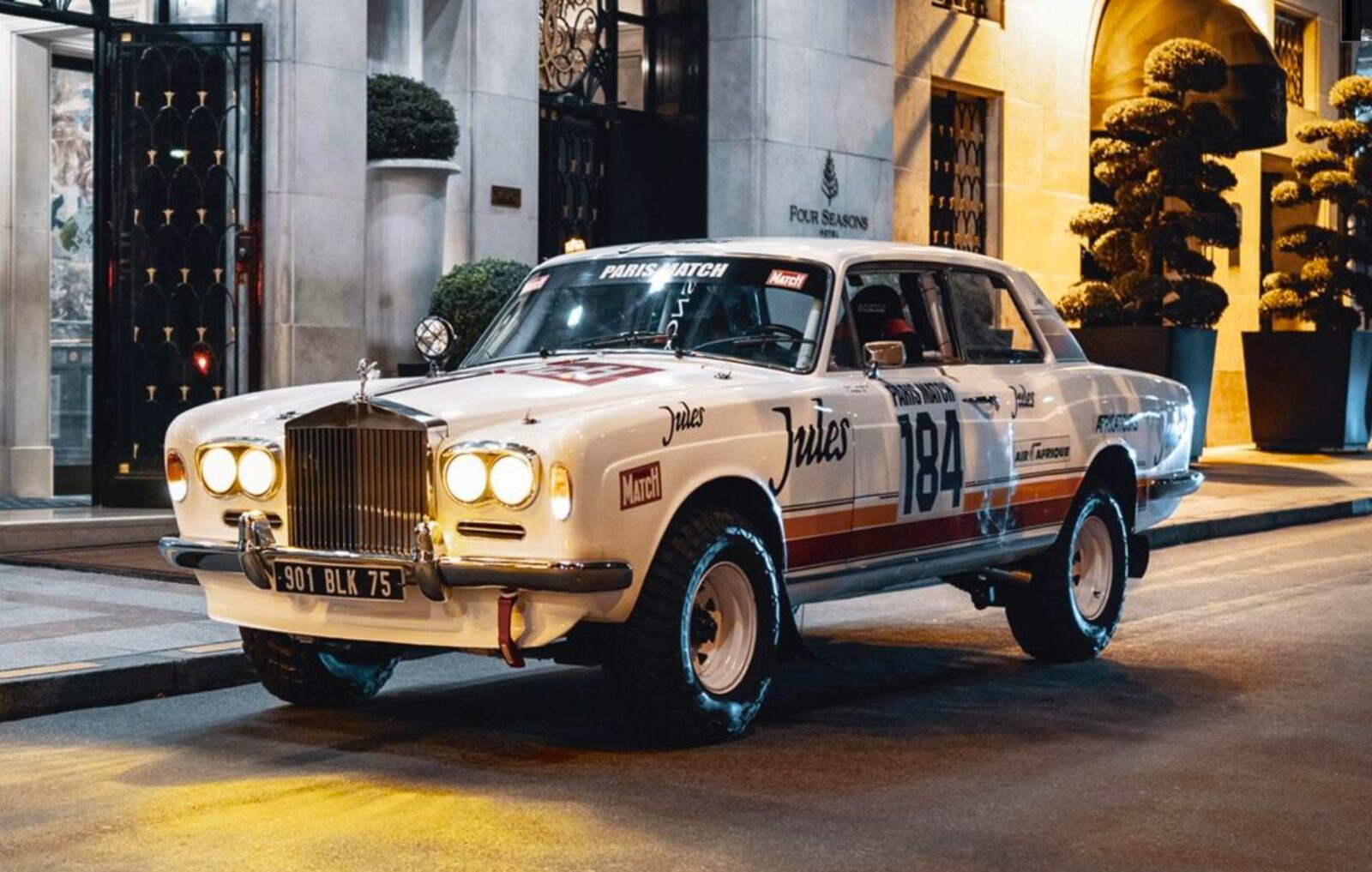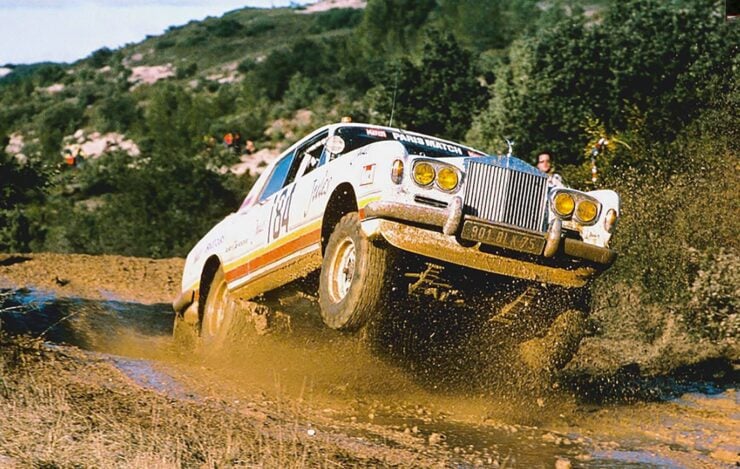This is almost certainly one of the most famous racing Rolls-Royces ever made, a feat made all the more impressive by the fact that Rolls-Royce didn’t want it made at all and very nearly had the project shut down.
The vehicle was named “Jules” after the Christian Dior cologne, with the French fashion house sponsoring the entry into the 1981 Paris-Dakar Rally and smoothing things over with Rolls-Royce in the process. The car would be running as high as 13th by the halfway point of the race, but an accident that damaged the steering removed it from contention – though it did successfully cross the finish line.
Fast Facts – The 4×4 Rolls-Royce Prototype “Jules”
- This 4×4 Rolls-Royce, named “Jules,” is a custom-built rally racer loosely based on a Rolls-Royce Corniche. It competed in the 1981 Paris-Dakar Rally and it has a fiberglass body, a Toyota Land Cruiser chassis, and a 5.7 liter Corvette V8 engine.
- Sponsored by Christian Dior to promote its cologne “Jules,” the vehicle carried extensive branding. Despite Rolls-Royce initially opposing the project, Dior’s involvement allowed it to proceed.
- “Jules” performed impressively in the rally, climbing as high as 13th place before a damaged steering system disqualified it. Nevertheless, it completed the race, garnering significant media attention and cementing its status as a legendary Paris-Dakar Rally competitor.
- Now offered for public auction by Aguttes, the one-of-a-kind 4×4 Rolls-Royce has an estimated value between $421,000 and $842,000 USD.
How “Jules” Came To Be
The existence of the one-off Rolls-Royce four-wheel drive named Jules comes down to two wealthy French playboys, Thierry de Montcorgé and Jean-Christophe Pelletier, and a few bottles of (only the best) French wine. At some point in their Bordeaux-infused evening they struck upon the idea of turning Thierry’s Rolls-Royce Corniche into a four-wheel drive desert racer, and then taking part in the Paris-Dakar Rally with it.
Above Video: This episode from Project Dream is focussed on Jules, the 4×4 Rolls-Royce Corniche that raced in the 1981 Paris-Dakar Rally.
Now usually these wild ideas that seem like unbridled genius when knee-deep in Châteauneuf-du-Pape don’t seem quite so brilliant in the cold light of dawn. Fortunately for the motoring world, Thierry and Jean-Christophe decided to move ahead with the plan – and thus the most outlandish Rolls-Royce of the time came into being.
Building A Rally-Ready Rolls-Royce
The original plan had been to use the Rolls-Royce Corniche body mounted to a four-wheel drive chassis, but this was soon axed. The steel unibody of the Corniche was based closely on the Rolls-Royce Silver Shadow, and it was simply too heavy to ever be competitive. The car tipped the scales at almost 5,000 lbs.
As a result of this, it was decided that an exact fiberglass replica of the body of the car would be built, using Thierry’s Corniche to make the mould. The only Rolls-Royce parts that were used were the windows, the chrome bumpers, the dashboard, that famous front grille, and the steering system.
The project was headed up by Michel Mokrycki, a man well-versed in preparing rally cars including a series of Citroën prototypes.
A search was completed to find a four-wheel drive chassis with a wheelbase close to the Corniche, and they settled on the Toyota Land Cruiser, specifically the HJ45 variant. The final vehicle would keep the steel ladder frame, the axles, brakes, leaf springs, transmission and transfer case, but the original engine would be swapped out for something far more fun – a Corvette V8.
The use of a 5.7 liter Chevrolet Corvette V8 made a lot of sense, it was a well-tested engine that produced gobs of torque and horsepower, and it was actually a pretty reliable unit with the right care. It also sounded right – the original engine in the Corniche had been the 6.75 liter Rolls-Royce L410 V8, so it was the correct engine architecture to boot.
A set of white steel wheels were added, shod with suitable off-road tires of course, and tubular steel framing was added under the body for additional strength. A full roll cage was fitted inside along with racing bucket seats and a rally-style steering wheel, then a 332 liter fuel tank was fitted in the rear to ensure that Jules would have enough range to make it between the distant fuel stops on the Paris-Dakar.
Christian Dior Saves The Day
When Rolls-Royce got wind of the project they took immediate action to have it shut down, on intellectual property grounds, but fortunately for all involved the project’s founders had an ace up their sleeve – they had signed on Christian Dior as their key sponsor. As the story goes, it would be Christian Dior who successfully talked Rolls-Royce down and allowed the project to proceed.
The reason Christian Dior chose to sponsor the wild-looking 4×4 Corniche was that they had a new product they needed to market to men, and they realized that very few men would be able to resist the appeal of a Rolls-Royce Paris-Dakar racer.
This new product was their cologne named “Jules,” and so the car would carry extensive Jules branding and be officially named “Jules” as a result.


The 1981 Paris-Dakar Rally
Jules would take part in the 1981 Paris-Dakar Rally, with Thierry de Montcorgé and Jean-Christophe Pelletier sharing co-driving duties, and as the stories go they took a supply of champagne and oysters with them – both of those commodities are famously hard to find in the Sahara.
The car performed surprisingly well, regularly finishing stages inside the top 20 from a field of 291 entrants. By the halfway point of the race, Jules was up in 13th position, shocking many in the event. This is when disaster struck, the car hit a tree and the steering was damaged, a local mechanic was able to perform a repair but it took so long that the car was disqualified from the official results.
Despite this disqualification, the event founder Thierry Sabine gave permission for the car to finish the race and cross the line – it wouldn’t be classified in the final results but it did complete the full course.
Christian Dior would receive millions of francs worth of publicity for their relatively modest outlay, vindicating the risk they had taken on the project.
Perhaps the most humorous element to the whole story is that after the rally, when the images of the Rolls-Royce Corniche 4×4 began appearing in newspapers and magazines around the world, Rolls-Royce was inundated with dozens of calls and letters from people who wanted to buy their own Corniche 4×4.


Decades later the British luxury automaker would unveil the Rolls-Royce Cullinan, a four-wheel drive Rolls-Royce designed by Giles Taylor. Although they would never admit it, a small part of the Cullinan’s DNA can be traced all the way back to a pair of fun-loving French playboys working their way through a case of Bordeaux one evening, and coming up with an idea for the greatest Rolls-Royce Dakar racer of all time.
Jules is now being offered for sale for the first time at public auction by Aguttes. It has a price guide of approximately $421,000 – $842,000 USD. If you’d like to read more about it or register to bid you can visit the listing here.










Images courtesy of Aguttes









